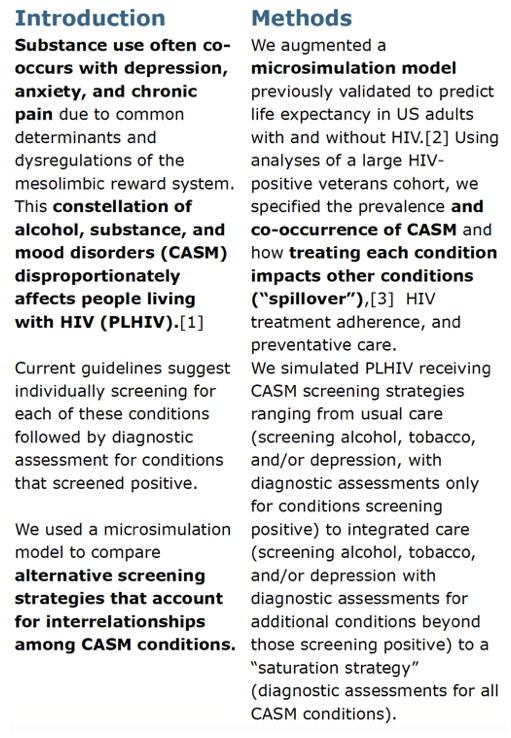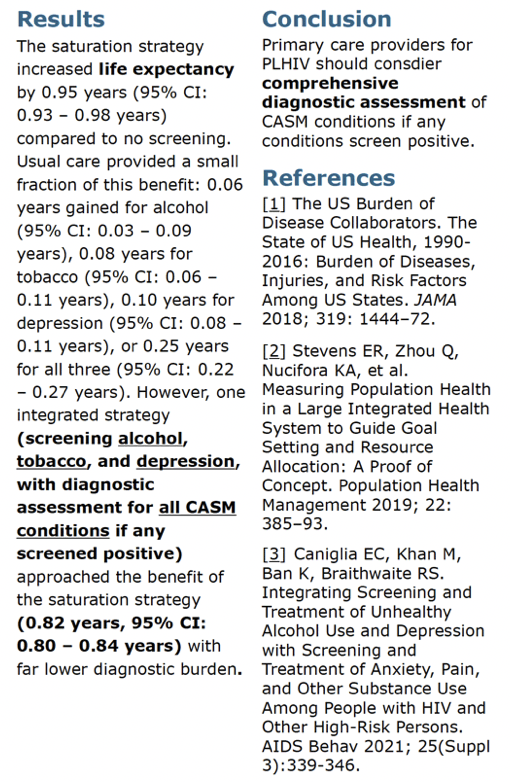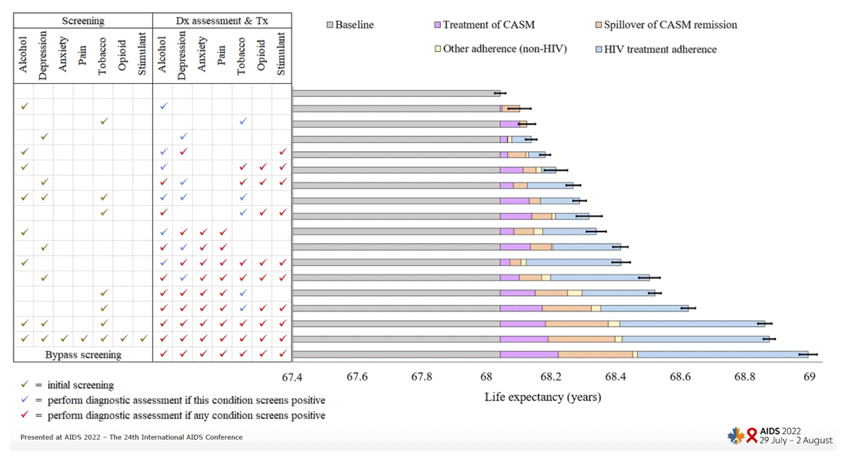 |
 |
 |
| |
Integrated Screening/Diagnosis for Alcohol, Tobacco, Depression May Extend Life With HIV
|
| |
| |
AIDS 2022, July 29-August 2, Montreal
Mark Mascolini
Integrated screening and diagnostic assessment of alcohol use, tobacco use, substance use, depression, anxiety, and chronic pain in people living with HIV may add nearly a year of life, according to a modeling study involving US veterans with HIV [1]. In contrast, standard screening for alcohol use, tobacco use, and/or depression and doing diagnostic assessments only for conditions that screen positive added only a few weeks to life expectancy.
In people with or without HIV infection, substance use often affects individuals with depression, anxiety, and chronic pain because similar factors may underlie all these conditions. A constellation of alcohol use, substance use, and mood disorders (CASM) affects higher proportions of people with HIV than the general population [2]. Standard practice in assessing these conditions involves screening for each problem individually then performing diagnostic assessments only for conditions that screen positive.
Researchers from the NYU Grossman School of Medicine and collaborators at other centers aimed to test alternative screening strategies with a microsimulation model accounting for interrelationships among CASM conditions. Prior work validated the accuracy of this model in predicting life expectancy in HIV-positive and -negative US adults [3]. Using a large group of HIV-positive US veterans, the investigators assessed the prevalence of CASM conditions, their co-occurrence, and how treating each condition affects other conditions [4], treatment adherence, and preventive care.
The model simulated different CASM screening strategies, ranging from standard care (screening for alcohol use, tobacco use, and/or depression and undertaking diagnostic assessments only for conditions for which a person screened positive), through integrated care (screening for alcohol use, tobacco use, and/or depression and undertaking diagnostic assessments for conditions that screened positive plus additional conditions), to a saturation strategy (screening for alcohol use and so on and conducting diagnostic assessments for all CASM conditions if only any screened positive).
Modeling predicted that, compared with no screening, a saturation strategy would boost life expectancy by about a year (0.95 year, 95% confidence interval [CI] 0.93 to 0.98). In contrast, standard care offered a relatively small increment in life expectancy: screening for alcohol use alone, 0.06 year (3 weeks) gained (95% CI 0.03 to 0.09), screening for tobacco use alone, 0.08 year (4 weeks) gained (95% CI 0.06 to 0.11), screening for depression alone, 0.10 year (5 weeks) gained (95% CI 0.08 to 0.11), and screening for all three conditions but doing diagnostic workups only for conditions that screened positive, 0.25 year (13 weeks) gained (95% CI 0.22 to 0.27).
Next the researchers looked at an integrated strategy—screening for alcohol use, tobacco use, and depression with diagnostic assessment for all CASM conditions if any single condition screened positive. In this scenario, the model predicted 0.82 years (43 weeks) of life gained (95% CI 0.80 to 0.84), almost as much life gained as the saturation strategy, but with less time spent screening all the CASM conditions up front.
On the basis of these results, the research team argued that "primary care providers for people living with HIV should consider comprehensive diagnostic assessment of CASM conditions if any conditions screen positive."
References
1. Bershteyn A, Richard EL, Khan MR, et al. Potential health benefits of integrated screening strategies for alcohol, tobacco, and other substance use, and depression, anxiety, and chronic pain among PLHIV in the United States. AIDS 2022, July 29-August 2, Montreal. Abstract EPB071.
2. The US Burden of Disease Collaborators. The State of US Health, 1990-2016: Burden of diseases, injuries, and risk factors among US states. JAMA. 2018;319:1444-1172.
3. Stevens ER, Zhou Q, Nucifora KA, et al. Measuring population health in a large integrated health system to guide goal setting and resource allocation: a proof of concept. Population Health Management. 2019;22:385-393.
4. Caniglia EC, Khan M, Ban K, Braithwaite RS. Integrating screening and treatment of unhealthy alcohol use and depression with screening and treatment of anxiety, pain, and other substance use among people with HIV and other high-risk persons. AIDS Behav. 2021; 25(Suppl 3):339-346. AIDS Behav 2021; 25(Suppl 3):339-346 saturation strategy means screening for all of the CASM conditions and doing diagnostic assessments for all CASM conditions if even one screens positive.




|
| |
|
 |
 |
|
|